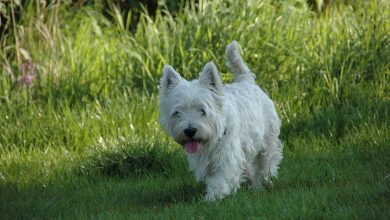Degenerative Myelopathy
Koko : A Case Study
One of the things I really like about my job is being able to meet new people and help and guide them with any concerns they may have about their faithful companions.
My hard work has given me an added skill set so that I can treat animals as well as humans, and being a Westie owner, I am naturally on some Westie Facebook groups, two of which have asked me to be their resident expert for group members who have any questions regarding musculoskeletal issues with their Westies.
While it is always harder to advise without actually having the dog there to put my hands on, COVID-19 has encouraged us all to find new ways of being able to work and help, and while it has been a challenge, I have been thrilled to do it.
However, I am not a vet, and should I see anything that requires an immediate vet visit I don’t hesitate to say so. The other benefit of being a so-called resident expert is that I have been able to meet new people from all over the world and become friends with some, no more so than the lovely Debra who lives in the United States.
Debra contacted me in April via one of the Westie groups to ask for some advice for her beloved Australian Shepherd, Koko (she also has a Westie called Bizzy) who had some issues with her legs and had developed a fever of unknown origin. Debra asked if I had ever come across something like this and if I had any ideas where the fever might be coming from and what she could do to help to help with the stumbling.
In March 2021 Koko, who was already stumbling, started to decline to the point where she was struggling to pull herself up. The vet initially thought it was arthritis but over the course of three weeks the medication had no effect. This is when her fever began.
Debra decided to take Koko to another vet for a second opinion, the vet gave Koko an injection of steroids and another for infection (Penicillin), Debra was sent home with some further injections. These seemed to help as she was walking better although still unable to pull herself up, her appetite had improved which was a good sign. However, the fevers had started to climb, another antibiotic was added to the injections along with medication for anxiety and pain yet the fevers persisted. The vet checked the bloods and found elevated liver enzymes and suggested an abdominal ultrasound. It was suspected that the original injections had been inflaming poor Koko’s liver.
Debra was advised to take Koko to a University Vet School where they performed an array of tests yet could not identify where the origin of the fever was. When Koko arrived home, she was given steroids and antibiotics, her walking improved most days but there were still times where she was stumbling and other days she could hardly stand.
Whilst the vet suspected a neurological condition called Degenerative Myelopathy, this is an incurable, progressive disease of the spinal cord. Progressive weakness and incoordination of the rear limbs are often the first signs, over time this progression can cause complete paralysis. The disease progresses due to the protective covering of the spinal cord (myelin sheath) breaks down. Front limb lameness will occur at a much later date followed by respiratory muscle paralysis which unfortunately necessitates euthanasia.
However, Degenerative Myelopathy does not cause a fever so there was a concern that something else was also happening. Having reviewed the x-rays I spotted some disc bulges which would account for the limb weakness, but by no means the complete answer as Koko was an older dog, so this was possible anyway. Plus, the disc bulges in the low back would potentially explain the hindlimb issues but not the forelimb instability.

By the middle of June, Debra had found that Koko had developed a horrible abscess on her right shoulder, the abscess was the biggest I’ve ever seen and was roughly the size of a tennis ball. More antibiotics were given, and warm compresses applied. After a couple of weeks, it started to improve and the abscess began to drain, cultures were taken, and it was found that she had a Staphylococcal infection. Come July she had developed head tremors and was prescribed phenobarbital which helped until the medication wore off. At this point she had started to develop some forelimb issues too where the right front paw would curl when she walked.
Abscesses are difficult to treat and need careful management. When they drain, they usually drain through a hole and leak fluid, however it has been known to occasionally have two drainage sites and this could potentially mean draining into the body. With Koko it’s highly possible two separate issues were taking place, Degenerative Myelopathy and then an infection via the abscess at the injection site.
This case really got my thinking cap on as it wasn’t straight forward as it became clear two things were happening at the same time. Sometimes medicine just isn’t straight forward. Challenges occur but then that’s what makes my job and life exciting and you never stop learning. Sadly, for Koko, despite the best care she received, she lost her battle in July 2021.
What is Degenerative Myelopathy?
Degenerative Myelopathy is an incurable, progressive disease of the covering of the spinal cord, brain, and nerves (myelin sheath). The myelin sheath allows for electrical impulses to transmit quickly and efficiently along nerve cells, this allows for our smooth locomotion. When the myelin sheath is damaged these impulses slow down and cause alterations in daily functions such as walking and breathing to name a few.
Diagnosis is by a series of tests and scans along with clinical signs and an absence of other clinical disease, meaning other clinical diseases with similar signs and symptoms need to be excluded first. It is also likely that the vet will perform:
- An MRI scan of the spinal cord and brain
- A sample of the fluid (cerebrospinal fluid) that surrounds the spinal cord
- Blood tests
In the early stages of Degenerative Myelopathy, the symptoms resemble that of arthritis and usually start with the hindlimbs before progressing up the body:
– stiffness in walking
– difficulty getting up
– the hind paws knuckle/turn under especially when turning
– the hips start to sway when standing still
– scraping of the hind paws when walking
As the condition worsens bowel and bladder functions may be compromised and incontinence may occur, the dog’s mobility becomes severely restricted and breathing may become problematic.
As of yet there is no cure for this condition and the only option is palliative care such as rehabilitation, hydrotherapy and medication to help support and maintain an acceptable quality of life.
As this is usually a condition affecting older dogs it is not uncommon for the dog to be affected by more than one complaint, such as intervertebral disc disease (bulging discs) so care must be taken to understand the true underlying complaint.
How to Treat an Abscess
An abscess is a tender swelling/mass that is generally surrounded by a reddish area. They occur when the skin barrier is broken down and bacteria enters the skin. The centre of the abscess liquefies and contains dead cells and bacteria. As the area begins to grow, tension is formed under the skin and inflammation occurs.
Unlike other infections an abscess won’t just go away with antibiotics. Abscesses need to be opened and drained in order for them to improve and the best way to do this is by using a warm compress to the area. This draws the infection towards the skin where it then opens and drains. If this doesn’t resolve it then the vet may decide to do this under anaesthetic.
Abscesses can become painful and warm and tender to the touch. It is important to deal with an abscess as quickly as possible and bring the infection to the skin for drainage because if the infection spreads deeper into the tissue a fever may develop and the feeling of being unwell can occur.
Faye Andrews is a canine & human osteopath.
Faye qualified in human osteopathy in 2002 from the British School of Osteopathy. She then completed her Masters in Canine Osteopathy from the European School of Osteopathy in 2018. Faye currently runs her own clinic in Surry alongside teaching both human and canine Osteopathy.






